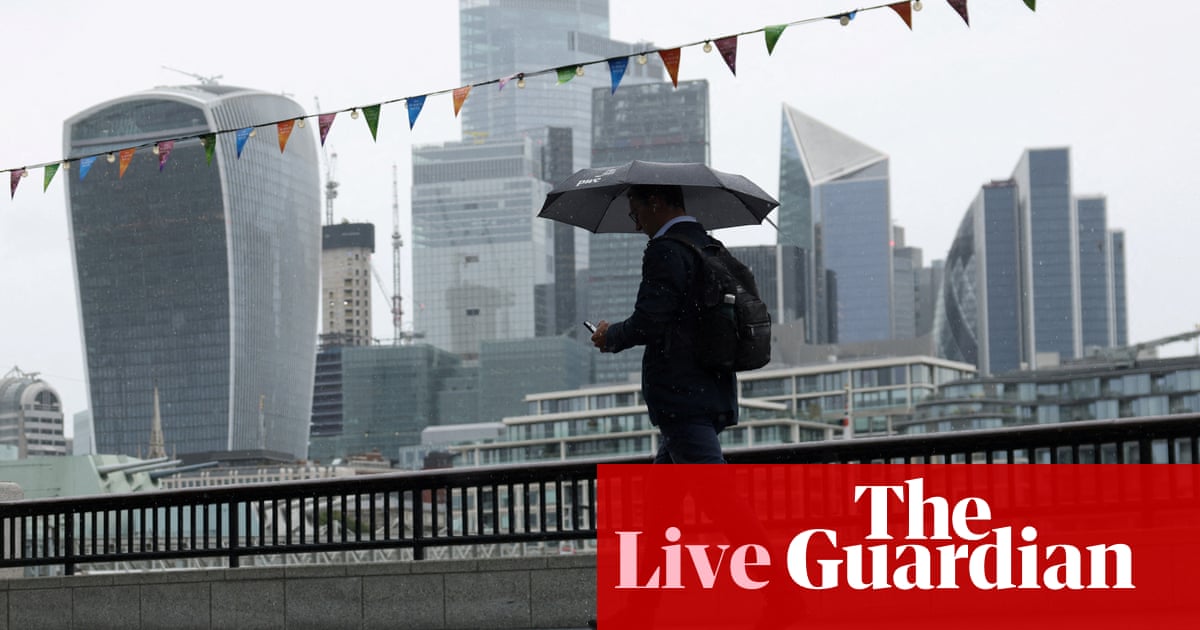Bussiness
UK to be slowest-growing G7 economy next year, warns OECD – business live

The latest real-time data tracking the UK economy is out, showing a dip in consumer spending last week and lower job adverts than a year ago.
The Office for National Statistics reports:
-
SPENDING/BEHAVIOUR – Aggregate UK spending on credit and debit cards decreased by 1% in the latest week and fell by 8% when compared with the equivalent week of 2023; while, when compared with the previous week, retail park footfall increased by 3% and transactions at Pret A Manger stores increased in 8 of 10 location categories.
-
JOB ADVERTS – Figures from Adzuna show the total number of online job adverts on 26 April 2024 remained broadly unchanged when compared with the previous week but was 20% below the level seen for the equivalent period of 2023.
New economic activity and social change data shows increases in:
🛍️ UK retail footfall
🥪 transactions in 8 of 10 @Pret location categoriesIn contrast credit and debit card spending decreased 💳
Read more ➡️ https://t.co/qB2rHh2jLg pic.twitter.com/S5En1jDn3s
— Office for National Statistics (ONS) (@ONS) May 2, 2024
Figures from @Adzuna show the total number of online job adverts on 26 April 2024 remained broadly unchanged when compared with the previous week 💻
This was 20% below the level seen for the equivalent period of 2023. pic.twitter.com/v4YsIhRcHg
— Office for National Statistics (ONS) (@ONS) May 2, 2024
PwC: UK stuck in slow-growth lane
Today’s OECD forecasts show the UK is stuck in the ‘slow growth’ lane, warns Barret Kupelian, chief economist at PwC UK
Kupelian explains:
“The OECD expects UK economic activity to grow by 0.4% this year and 1% next year. However, the OECD’s forecasts show the UK is stuck in the ‘slow growth’ lane, when compared to other large European economies. This is also supported by our own in house forecasts.
“In the short-term, we expect economic activity to pick up, mainly led by private sector activity and consumer spending. Some of this will be helped by the Bank of England likely gradually easing its monetary policy in the second half of the year. The report suggests there is momentum to the UK’s economic turnaround in key economic areas, including house purchase activity and a rise in both consumer and business confidence.
“Long term, the UK will need to build a comprehensive industrial and services plan which addresses its main economic shortcomings, i.e. planning rules, skills reform, and issues surrounding the provision of public services. Building a framework to address these areas whilst also dealing with the green and digital transitions will be key to grow private and public sector productivity and resilience.”
OECD: UK monetary policy will ease from Q3
The OECD expects the Bank of England will start to cut interest rates by the autumn.
It says:
Monetary policy is assumed to start easing from the third quarter of 2024, with Bank Rate gradually lowered from its current peak of 5.25% to 3.75% by the end of 2025, as inflation continues converging towards target.
Incidentally, the OECD’s chief economist, Clare Lombardelli, is joining the BoE this summer as deputy governor.
The OECD also predicts that UK unemployment will rise “as the labour market cools”.
It also expects that rising wages will support consumer spending over the next two years.
While that’s better news for workers, it could also add to inflation pressures – making it harder for the Bank of England to lower interest rates.
The OECD’s report says about the UK:
GDP growth is projected to remain sluggish at 0.4% in 2024 before improving to 1.0% in 2025, reflecting the waning drag from past monetary tightening.
Stronger real wage growth will support a modest pick-up in private consumption. Headline inflation is expected to continue moderating towards target as energy and food prices have eased substantially, but persistent services price pressures will keep core inflation elevated at 3.3% in 2024 and 2.5% in 2025.
Unemployment will continue increasing and reach 4.7% in 2025 as the labour market cools, although the actual degree of slack remains uncertain.
Here’s another chart showing the OECD’s new inflation forecasts:
Here’s Darren Jones MP, Labour’s Shadow Chief Secretary to the Treasury, on the OECD’s warning that Britain will be the slowest-growing member of the G7 in 2025.
“Today’s news that growth has been downgraded again reminds the British people what they already know: after 14 years of failure, the Conservatives cannot fix the economy because they are the reason it is broken.
“It’s time for change. Only Labour has a long-term plan to grow the economy and make working people better off.”
Novo Nordisk raises outlook fuelled by weight loss drug demand
Novo Nordisk, the Danish pharmaceutical company behind the Wegovy weight loss drug, has beaten profit expectations as demand booms.
Novo Nordisk’s sales increased by 22% in the first quarter, while operating profit rose by 27%.
CEO Lars Fruergaard Jørgensen says:
“We are pleased with the sales growth in the first three months of 2024, driven by increased demand for our GLP-1-based diabetes and obesity treatments,”
Booming demand for Wegovy – which was made available in the UK last September – drove up Novo Nordisk’s share price to record levels and making it Europe’s most valuable company.
The company has lifted its forecasts for the year. It now expects sales growth this year of between 19% and 27% in local currencies, compared to the previously guided range for 18% to 26% growth.
Operating profit growth this year is now seen at between 22% and 30% in local currencies, slightly up from its previous forecast of 21% to 29%.
However, Novo’s share price has dipped by 1.5% this morning.
Hunt: We’re winning the war on inflation
Chancellor of the Exchequer Jeremy Hunt has said the OECD’s forecast isn’t a surprise.
Responding to today economic outlook, Hunt says:
“This forecast is not particularly surprising given our priority for the last year has been to tackle inflation with higher interest rates.
But now we are winning that war, growth matters which is why it is significant that last month the IMF predicted the UK will grow faster over the next 6 years than any European G7 country or Japan. To sustain that we need to stick to our plan – competitive taxes, a flexible labour market and far-reaching welfare reform.”
However, the OECD’s forecasts shows inflaton will be HIGHER in the UK this year than in the US, Germany, France, Italy or the European Union, although lower than the OECD average.
UK inflation is forecast to average 2.7% this year and fall to 2.3% next year – still above the Bank of England’s target –
Argentina, though, could suffer 200% inflation this year:
The OECD blames high interest rates for Britain’s weak growth outlook, after the Bank of England lifted borrowing costs to a 16-year high.
It says:
“GDP growth is projected to remain sluggish [in the face of a] waning drag from past monetary tightening.”
OECD chart: UK will have weakest growth across the G7 in 2025
The OECD’s new forecasts (see here) suggest the UK will be the second-weakest growing advanced economy this year, and the slowest next year.
For 2024, Germany is expected to be the slowest G7 member with just 0.2% growth, behind the UK’s 0.4%, and Japan at 0.5%.
France and Italy (and the eurozone) are seen growing by 0.7% this year, while Canada is expected to grow by 1%, with the US (again) in the lead with 2.6% growth.
But for 2025, the UK slips to the back, with 1% growth, behind Germany at 1.1%.
The OECD also forecasts a very deep recession in Argentina, followed by a recovery in 2025, as president Javier Milei drives though his free market reform package.
The OECD says:
Developments continue to diverge across countries, with softer outcomes in many advanced economies, especially in Europe, offset by strong growth in the United States and many emerging market economies.
OECD cuts UK growth forecast
Newsflash: Britain’s economy will grow slower this year and next than previously thought, the Organisation for Economic Co-operation and Development has warned.
New OECD forecasts also show the UK will suffer higher inflation than its peers.
The OECD cuts its British economic growth forecast to 0.4% for 2024, down from 0.7% forecast in February.
UK growth next year is expected to rise to 1.0%, compared with a previous forecast of 1.2%.
It means the OECD expects Britain’s economy will grow more slowly in 2025 than France or Germany.
Consumer prices are expected to rise more quickly in Britain during 2024 and 2025.
OECD SEES 2024 UK GROWTH OF 0.4% (0.7% PREVIOUSLY), 1% IN 2025 (1.2% PREVIOUSLY).
— FinancialJuice (@financialjuice) May 2, 2024
Looking more broadly, the OECD says global activity has proved surprisingly resilient so far.
Global GDP growth is projected to be 3.1% in 2024 and 3.2% in 2025, compared with 3.1% growth in 2023.
The OECD says:
Global growth in 2023 continued at an annual rate above 3%, despite the drag exerted by tighter financial conditions and other adverse factors, including Russia’s war of aggression against Ukraine and the evolving conflict in the Middle East.
Global GDP growth is projected at 3.1% in 2024 and 3.2% in 2025, little changed from the 3.1% in 2023. This is weaker than seen in the decade before the global financial crisis, but close to currently estimated potential growth rates in both advanced and emerging market economies.
BNY Mellon: Fed sets the stage for a volatile summer
The Fed has set the stage for “a volatile summer ahead”, says BNY Mellon’s macro strategist John Velis.
He told clients:
The outcome of this week’s Federal Open Market Committee meeting turned out to be less hawkish than we – and apparently markets – expected.
The key phrase in the statement was unchanged, “The Committee does not expect it will be appropriate to reduce the target range until it has gained greater confidence that inflation is moving sustainably toward 2 percent.”, so the Fed continues to affirm its bias towards easing policy.
Velis added:
To us, this decision to hold, and to still view an eventual cut as the most likely future move, sets the stage for a volatile summer ahead.
Effectively, the Fed is data dependent, meaning every data release – especially as relates to inflation – acts as a referendum on where the Fed will go (or not go). There hasn’t been a lot to suggest inflation is going to moderate.
One of Jerome Powell’s predecessors, Alan Greenspan, once remarked: “If I seem unduly clear to you, you must have misunderstood what I said.”
And today, investors seem to broadly agree that the Fed wasn’t as hawkish as it could have been…
Goldman Sachs are in the dovish camp – they still expect two rate cuts this year:
Jim Reid, strategist at Deutsche Bank, says “it’s hard to say it was a dovish meeting”:
The main flashes from the Fed last night was that while the FOMC made several hawkish tweaks, Powell signalled that rate hikes remained unlikely and the Fed announced a slightly-larger-than-expected slowing of QT.
It’s hard to say it was a dovish meeting but given the recent inflation prints it could have been a lot more hawkish.
Kyle Rodda, analyst at capital.com, argues that the Fed’s tone was “less-hawkish-than-feared”.
Ultimately, the bar was set high for a hawkish surprise last night, and the central bank did not attempt to leap it, striking an overall neutral tone and leading to a brief flurry of bullishness in the market.
Slightly more than one cut was baked into the futures curve going into the meeting, with the odds of another increasing at the margins after last night’s meeting. As a result, yields edged lower, and the US Dollar dropped, with gold also rallying.
Anger as Shell beats profit forecasts
Energy giant Shell has beaten City expectations this morning by reporting adjusted earnings of $7.7bn for the first quarter of 2024.
Shell’s earnings were lower than a year ago – it made a bumper $9.6bn in Q1 2023 – but well above analyst predictions of $6.5bn.
Shareholders will – again – benefit, with Shell announcing a new $3.5bn share buyback programme this morning.
CEO Wael Sawan says:
“Shell delivered another quarter of strong operational and financial performance, demonstrating our continued focus on delivering more value with less emissions,”
Alexander Kirk, fossil fuel campaigner at Global Witness, says such huge profits show the energy system simply doesn’t work:
“Shell continuing to rake in huge sums of money shows us that huge polluter profits were not a one-off but are the twisted reality of an energy system that benefits climate-wrecking companies to the cost of everyone else.”
“Companies like Shell saw record profits while the energy crisis dragged millions of families into poverty through unaffordable energy bills. Meanwhile fossil fuel giants fought hard against paying more tax.
“This is the sad irony of the global energy system in which those causing chaos are the ones getting rich. This spiral won’t stop until we make the urgent switch to a fairer renewable energy system that puts both people and planet first.”
Two UK rate cuts in 2024 are not fully priced in
Back in 1971, the US Treasury Secretary John Connally caused a stir by declaring that “The dollar is our currency, but it’s your problem.”
And the Federal Reserve’s stance on interest rate also has global implications. If US interest rates stay higher for longer, it’s hard for other central banks around the world to cut interest rates without weakening their currencies against the greenback (which is inflationary).
Investors have been cutting back on their forecasts for early cuts to UK interest rates.
Currently, the money markets are pricing in around 42 basis points of cuts to UK rates this – that means one quarter point (25bp) cut is certain and a second is possible.
In early trading this morning, the first Bank of England rate cut is fully priced in for September, although there’s a greater than evens chance it will happen in August.
Introduction: Fed chair chair Powell signals interest rates will remain higher for longer
Good morning, and welcome to our rolling coverage of business, the financial markets and the world economy.
Hopes of early interest rate cuts are fading today after America’s central bank left borrowing costs on hold last night and chafed at the ‘lack of further progress’ on inflation.
Last night, the Federal Reserve left its policy rate unchanged, as expected, given inflation rose back to 3.5% in March – further from its 2% target.
The Fed was clear that recent data has not given it the confidence it needs that inflation is moving sustainably toward target.
Federal Reserve chair Jerome Powell told reporters last night:
It is likely that gaining such greater confidence will take longer than previously expected. We are prepared to maintain the current target range for the federal funds rate for as long as appropriate.
Powell added that the Fed was “prepared to respond” if the jobs market weakened unexpectedly.
The Fed chair indicated he simply didn’t know when interest rate cuts will be justified, but felt it unlikely that the Fed’s next move would be to hike rates.
FED’S POWELL: I DON’T HAVE GREAT CONFIDENCE EITHER WAY ON WHETHER THERE WILL BE RATE CUTS THIS YEAR.
— FinancialJuice (@financialjuice) May 1, 2024
The Fed did make one change – it slowed the pace of its quantitative tightening programme, under which it sells bonds bought under its stimulus programmes.
After a volatile session on Wall Street, the S&P 500 index closed down 0.35%.
Sneak Peek- April 2024 Newsletter: US equity markets corrected significantly last month. Expectations of multiple rate cuts have faded as inflation remains high. pic.twitter.com/IvSufw8yXS
— Gaurav Goel (@megauravgoel) May 2, 2024
Powell’s message was that current policy was in a good place, explains ING’s economics team. They told clients this morning:
At the press conference, Powell reiterated that he feels monetary policy is “restrictive” and that an interest rate hike is “unlikely”, but that will be up to the data to determine – he would need “persuasive evidence” that monetary policy isn’t tight enough.
He then repeated that 16 April comment that gaining confidence inflation is coming down and they can cut interest rates is taking “longer than thought” and he doesn’t know if it will be achieved this year. However, with inflation having moved below 3% he argues that the employment goal of the Fed comes back into focus.
He says the current policy stance “is in a good place” and in response to a question of a risk of stagflation – weakening growth and high inflation – he doesn’t see “the Stag or the Flation”.
US interest rates are currently set at a 5.25-5.5% range.
According to the CME Fedwatch tool, there’s now a 31% chance that the Fed will have cut interest rates twice by the end of this year – to 4.75%-5% – and a 38% chance of only one rate cut.
At the start of this year, investors expected six quarter-point cuts, but persistent inflation has dampened those expectations.
The agenda
-
8am BST: OECD to publish half yearly economic outlook
-
9am BST: Eurozone manufacturing PMI for April
-
9.30am BST: Hong Kong’s GDP report for Q1 2024
-
1.30pm BST: US trade balance for March
-
1.30pm BST: US weekly jobless data










